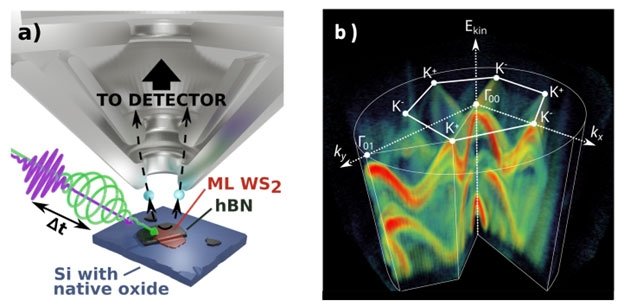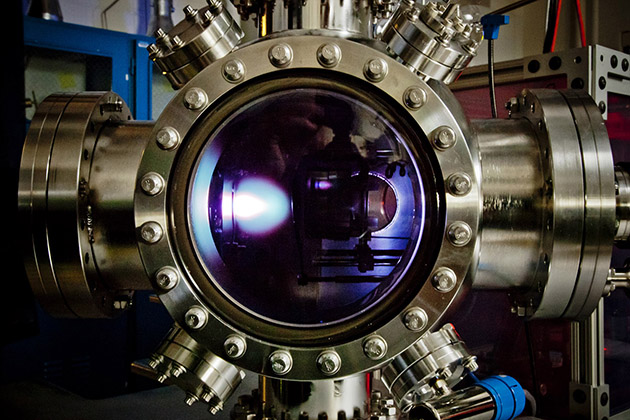Researchers have taken the first atomic-resolution images and demonstrated electrical control of a chiral interface state – an exotic quantum phenomenon that could help researchers advance quantum computing and energy-efficient electronics.
Tag: applied physics

Directly Imaging Quantum States in Two-Dimensional Materials
When some semiconductors absorb light, the process can create excitons, quasi-particles made of an electron bound to an electron hole. Two-dimensional crystals of tungsten disulfide have unique but short-lived exciton states. Scientists developed a new approach called time-resolved momentum microscopy to create separate images of these individual quantum states. The study found that the coupling mechanisms that lead to mixing of the states may not fully match current theories.
Quantum scientists accurately measure power levels one trillion times lower than usual
Scientists in Finland have developed a nanodevice that can measure the absolute power of microwave radiation down to the femtowatt level at ultra-low temperatures – a scale trillion times lower than routinely used in verifiable power measurements. The device has the potential to significantly advance microwave measurements in quantum technology.
Paradoxical quantum phenomenon measured for the first time
Some things are related, others are not. Suppose you randomly select a person from a crowd who is significantly taller than the average. In that case, there is a good chance that they will also weigh more than the average.
Coating bubbles with protein results in a highly stable contrast agent for medical use
Bacteria produce gas vesicles, tiny thin-walled sacs filled with air or fluid, to help them float. This captured the attention of researchers at Aalto University’s Department of Applied Physics, who saw the potential for similar bubble-based designs in fields like…

Rensselaer Polytechnic Institute’s Computer Science and Physics Departments Appoint New Leaders
Rensselaer Polytechnic Institute’s School of Science has appointed two new department heads. Mohammed Zaki now leads the Department of Computer Science and Gyorgy Korniss leads the Department of Physics, Applied Physics, and Astronomy. The departments are ranked third and fourth in the state of New York, respectively, and 24th nationally by College Factual.
Walking with coffee is a little-understood feat of physics
Using the cup-holding paradigm, new research indicates humans are able to switch abruptly and efficiently from one synchronous attractor to another, a mechanism that can be exploited for designing smart robots to adaptively handle complex objects in a changing environment.
One-dimensional red phosphorous glows in unexpected ways
In a study published in Nature Communications, an international team led by Aalto University researchers has found that fibrous red phosphorous, when electrons are confined in its one-dimensional sub-units, can show large optical responses – that is, the material shows strong photoluminescence under light irradiation. Red phosphorous, like graphene, belongs to a unique group of materials discovered in 2017 called one-dimensional van der Waals (1D vdW) materials.
One-dimensional red phosphorous glows in unexpected ways
In a study published in Nature Communications, an international team led by Aalto University researchers has found that fibrous red phosphorous, when electrons are confined in its one-dimensional sub-units, can show large optical responses – that is, the material shows strong photoluminescence under light irradiation. Red phosphorous, like graphene, belongs to a unique group of materials discovered in 2017 called one-dimensional van der Waals (1D vdW) materials.
Unlocking radiation-free quantum technology with graphene
New research shows how it is possible to create heavy fermions with cheap, non-radioactive materials. To do this, the researchers used graphene.
Watt Webb, biological imaging techniques pioneer, dies
Applied physicist Watt W. Webb, the S.B. Eckert Professor of Engineering Emeritus at Cornell University and a pioneer in methods for imaging living biological systems, died Oct. 29 in New York City. He was 93.

Toward an Ultrahigh Energy Density Capacitor
Researchers at Berkeley Lab and UC Berkeley have demonstrated that a common material can be processed into a top-performing energy storage material. Their discovery could improve the efficiency, reliability, and robustness of personal electronics, wearable technologies, and car audio systems.

NAU scientists partner in $26 million NSF initiative to establish new Center for Quantum Networks
In its first NSF Engineering Research Center collaboration, NAU will receive nearly $2 million in funding as a CQN contributing partner in the areas of research, education and workforce development.